
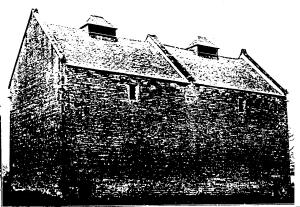 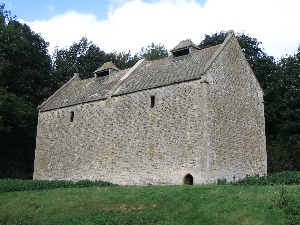 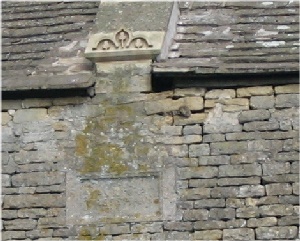  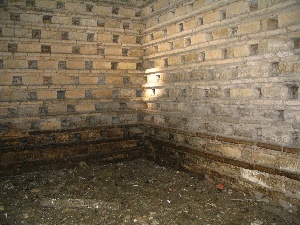 |
Passing eastward, the player
at this game of dovecote-hunting finds himself growing "warm" on entering
Northamptonshire. Dovecotes are numerous, though many have now disappeared;
they are curious in being for the most part either square or oblong, though
circular and octagonal examples are by no means absent; while many are but
a short distance from the county town. Let us award first place to a fine dovecote of unusual size. It will be found at Newton-in-the-Willows, a small village lying a little to the west of Geddington. Church, village, dovecote stand apart from one another; the last-named, lonely in a field, is all that now remains of a former manor-house belonging to the Tresham family. Its size is most unusual; fifty-three feet nine, by twenty-three feet seven; the height to the eaves twenty feet, and to the roof-ridge about thirty-five. Like similar pigeon-houses of this shape in Scotland, - where, however, they are mostly covered by a lean-to roof - the building is divided into two compartments of equal size, the party-wall being carried through the roof, which is of Colly Weston slabs. Each section of the roof has a small lantern to give entrance to the pigeons, furnished with alighting ledges facing south and north. The walls, of local limestone, have a marked "batter" sloping slightly inwards as they rise On three sides they are blank, being broken on the south side only by a heavily barred window giving light to each compartment, with a door to each. The doorways are noticeably small; three feet four inches high, and two feet wide. The doors themselves are almost certainly original, being made of solid oak four inches thick. In the middle of the south wall, between the windows, a stone slab bears the name "Maurice Tresham" in raised lettering. Above, at the end of the table-course over the dividing-wall between the two compartments, is the device of the Tresham family, a triple trefoil. This is repeated on the north side. and again on a stone which caps the ridge. Such is the only attempt at ornament on this great dovecote, and the building would present a somewhat bare and forbidding appearance, had not its old stones "weathered" to a richly variegated hue, largely due to the growth of many-coloured lichens. Each of the two compartments has accommodation for two thousand pairs of birds. The nests are empty now; but in the spring and summer wild bees make their nests in interstices in the walls; while daffodils and snowdrops, springing here and there about the meadow, tell of the old manor garden that has passed away. The dovecote's builder was, there can be little doubt, the first of several Maurice Treshams known to have existed in the family. He was born in 1530 and came into the estate when only eight years old. We visited and took these photographs on October 7,
2006. This immense dovecote still stands by itself in a field with a backdrop
of a small hill with woods. Standing there all alone, it feels even larger
than Cooke described. This is especially true when viewed from a slight distance,
when one surmises that the door would be about six feet high, which as Cooke
noted, it is not.
While a few pigeons were found in the dovecote, it is
now mostly frequented by sheep, which gain entry through the small doors. The door frame is still in very nice condition, as
can be seen in the photo, but sadly the doors appear to have been removed
to provide easy access for the sheep. The name plaque is still visible and
in fair condition. From ground level we could make out that it said Ma?????
Tresham. This fits with exactly what Cooke described, as he read it as Maurice
Tresham. A triple trefoil stone decoration above the name plaque appears
to have been recently repaired, so someone is still caring for this
dovecote in a loving way. Cooke did not describe the 2000 or so nest holes he found, and we certainly did not try to count them all growing weary after counting just one end gable at 277. It appears that the bottom two courses have been filled in at some time. You can make them out, along with the landing ledges the birds were provided with, even at the very lowest level. The nest hole construction is the standard checkerboard design. A potence clearly would not have worked in this structure, so a ladder or scaffolding of some type must have been in place for harvesting the squabs. There is no remaining evidence of either, however. This is not an easy dovecote to find. We found the village, but then had to cast about, and finally found a farm shop called Dovecote Farm, which we thought might be a clue. However, no one working there that day knew of a dovecote or knew why the shop was named Dovecote Farm. Undeterred, we poked around a bit and found a path leading off to the left of the shop, into a field, down a hill, and then to the left to the dovecote. It is a bit obscured by a grove of trees, so is quick in surprising and delightful to come suddenly upon a view of such a large and lovely dovecote. It is a walk of perhaps 1/4 mile from the shop in a field with cows and sheep |
|
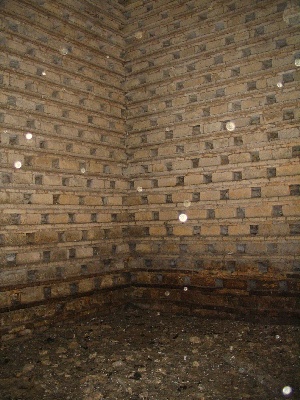 |
 |
 |
|
|
||
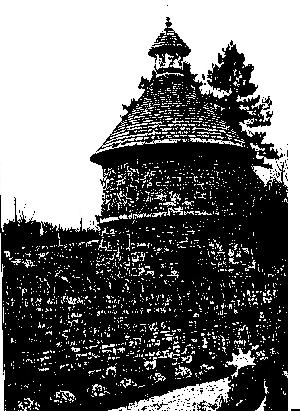 |
The village of Harleston, four
miles distant from Northampton on the Rugby road, offers a dovecote very
different from the Newton specimen, alike in situation, shape, and size.
The village itself is delightful, with its houses built of local sandstone,
roofed with thatch or tiles; the dovecote, far from standing lonely and deserted
in a meadow, peeps upon us from behind a garden wall.It is a round building
of local sand and ironstone, in some measure ivy-grown. The roof, renewed
three-quarters of a century ago, is of the well-known local Colly Weston
slates, and is topped by an octagonal lantern and a weathervane. The wall
is "set back" half-way up, with a good string-course; while a broad table-course
appears immediately below the eaves. The walls, fifteen feet high, are three
feet thick. Entrance is by a doorway four feet high, two feet one inch in
breadth. Internally the building is divided into two stories by a modern
floor, and holds about four hundred nests, now long disused. The thickness of the walls, the small size of the doorway, are good signs of age; but it is a somewhat doubtful tradition which dates this interesting structure to 1320, the year in which the parish church was rebuilt. More probably it has existed since the first quarter of the fifteenth century. Harleston can show another dovecote, far less picturesque, however, than the one just viewed. It is rectangular and almost square, the wall-length being twenty-one feet by twenty-three. The walls are three feet thick, but the doorway is unusually large - six feet in height, three feet three inches wide. The height to the eaves is sixteen feet. The roof, once covered with the famous local slates already spoken of, is now of small red tiles. The somewhat bald appearance of the whole is well toned down by a large pear-tree trained on the west wall, as also by the "weatherin" of the lichen-covered stones. A single window, narrow, tall, round-headed, breaks the western wall. The dovecote, probably about three hundred years of age, contains eight hundred nest-holes, all deserted now. |
|
| A word with reference to the largeness of
the doorway here. Though a small doorway may be looked on as a sign of age,
a larger entrance is not always indicative of modernity. The doorway, made
both small and strong for safety of the inmates, was found nothing but an
inconvenience when the dovecote, as a dovecote, fell into disuse, and it
was desired to employ it as a stable, cart-shed, or the like; so that a low
and narrow doorway has now often disappeared, being swallowed up in one of
modern size. In the same way the potence, useful when employed for its due
purpose, was found later to be in the way of carts or cattle, and has
consequently often been cast out. Still occupied by pigeons is the dovecote at Denton, a village six miles from Northampton, on the Bedford road. It is of limestone and circular; there are three "set-backs" to the walls,. the uppermost alone being provided with a string-course. The roof and its cupola date from the middle of the last century, but the building is much older. The doorway on the south is almost square, three feet six inches high, three inches less in breadth. |
||
 |
Isham, a village lying between Wellingborough
and Kettering, possesses an interesting seventeenth-century dovecote, rectangular
in shape, and having its massive walls built with a slight "batter." The
heavy door, thickly studded with nails, is worth noting, and the whole building
is maintained in good repair. It is still tenanted by a few birds.
We found this dovecote quite easily, as it sits right
next to the road across the street from the church. It is on private
property and no one was at home when we visited, so we could not explore
further. It is still in excellent condition and inhabited by pigeons.
While none were visible on the dovecote, there were many sitting on
the house itself, called "Dovecote House."  |
|
|
|
||
 |
Externally there is but little
special interest apparent in the circular cupola-crowned dovecote standing
near the mill at Warmington, a village between Oundle and Peterborough, three
miles from the former place; though we shall notice that its "Colly Weston"
roof is of a pleasant hue. Internally, this building, dating from the seventeenth
century, has features which demand attention.
We are fortunate with this dovecote, as it has been
"adopted" by the Northamptonshire County Council, which has gone far in
maintaining and refurbishing it for our collective enjoyment. The potence
has been fully restored and the nest holes have been restored in varying
stages of construction. This most thoughtful preservation makes it
easy to see how these very interesting nest holes were constructed. It
is actually quite amazing how the vertical supports were "dovetailed", no
pun intended, into the outer walls, and supported by a lower bench.
Cooke was right on in describing this most unusual of dovecotes, and I fully believe he was correct in supposing that this dovecote is indeed not only unusual, but unique. The photographs will go far in fleshing out the text description about the construction of the nest boxes because it is rather hard to visualize from the description alone. Not finding fault with his description, we could not do better, in part because the nest holes are so very different from any we have seen before. So, first Cooke's description and then our
photographs:.
Even the door detains us on our way within. It has two locks,
the upper one of modem make. The lower lock, probably as old as the building
whose occupants it was its office to secure, is of very elaborate construction.
It is contained in an oak case, well ornamented with iron-work. There is
a double key-hole with two separate bolts. The key, when inserted and turned
in the usual way, unlocks the upper bolt. The lower bolt is withdrawn by
both the position of the key and the direction in which it is turned being
reversed.The woodwork of the roof is original, the main supports being two
horizontal beams which cross in the centre. From each of these rises a curved
piece of timber, on which is supported a circle of wood to which the rafters
are fixed.The potence is still in complete order. The massive upright post,
six inches by four in section, is pivoted in a wooden block in the floor
and to the cross-beams which support the roof. It carries a sixteen-rung
ladder, which is strengthened by diagonal struts. |
|
 |
 |
But it is the construction of the nests which presents the chief internal feature of this dovecote. Two feet above the floor the walls are corbelled, a shelf six inches wide being formed. From this shelf rise perpendicular slabs of wood, fixed to the wall at distances nine inches apart Similar slabs rise from the floor, in front of those upon the shelf. These uprights are connected by round wooden pegs, placed horizontally, and long enough to project beyond the front row. Upon these pegs flat boards are laid to form the nest-floors, with upright boards to serve as the dividing walls. The whole arrangement was then covered with some kind of mortar or cement, a ledge being formed in front of every tier. Such an arrangement as here seen is most unusual, possibly unique. |
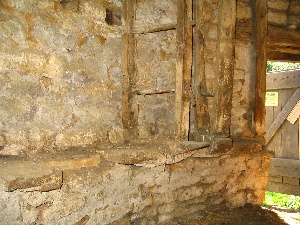 |
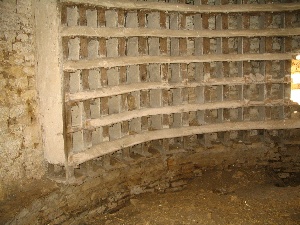 |
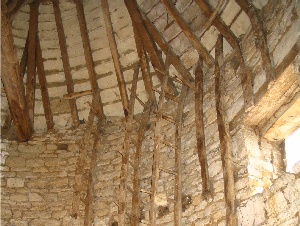 |
|
|
||
| At Burton Latimer, three miles from Kettering,
is a plain but well-built dovecote, almost identical in size and general
form with that at Isham. It offers no feature of special interest; and the
explorer will do well to turn his steps towards Dallington, a village but
a little distance from Northampton, on the Rugby road. Here, in the grounds
of Dallington House, upon the bank of a small stream, and reached through
a fine avenue of elms and chestnuts, he will find one of the few octagonal
dovecotes which the county offers. Dallington House, it should be noted,
was built about 1720 by Sir Joseph Jekyll, Master of the Rolls, on the site
of a manor-house which was once the home of Lord Chief Justice Raynsford.
The dovecote was most probably erected at the same time as the present
mansion.
It is a somewhat ornate, yet massive building, covered by
an eight-sided ogee roof, the whole crowned by an octagonal lantern. This
lantern is lead-covered, the angles of the roof of Colly Weston slabs being
likewise lead-protected. The walls two feet three inches thick. are of worked
ashlar, with the corner-stones of rustic work. The door, six feet in height,
but less than three feet wide, has evidently been enlarged; and two out of
three windows are certainly modern. The house, containing over thirteen hundred
nest-holes, is now empty, and the holes by which the birds once entered have
been closed. |
||
 |
We were unable to get a
better picture of this dovecote, as no one was at home when we knocked on
the door. The dovecote is obscured from the street side, because it lies
behind the house and several other farm type buildings, and so we had to
take this picture from the parking lot of the pub next door. The wall was
very tall and I needed to take this picture holding the camera over my head.
You do get a good view of the rather unusual pigeon entrance and the
very nice lantern with glass intact.  |
|
|
|
||
| Passing now into Buckinghamshire we find several
dovecotes of interest. At Haversham, in a field east of the Manor House,
is a seventeenth-century example of stone; square, with a pyramid-shaped
tiled roof, surmounted by a good oaken lantern. A panel in the north wall
bears the legend "1665 M.T." The dovecotes still fitted with nests, and,
unlike some others in the county, is in good repair. At Clifton Reynes is, or lately was, a circular dovecote, the walls of which have a slight set-off near the top. The thatched roof is crowned by a small lantern. Nests are fitted in the thickness of the walls. But the whole building was, a short time back, in such dilapidation that it may have been pulled down. |
||

|
At Church Farm, Edlesborough,
there exists, in company with a sixteenth-century barn and the remains of
a moat, a square brick dovecote built in the late seventeenth century, with
a tiled roof, and fitted with brick nests. To the South of Great Linford
Rectory, a building some four centuries old, is a square example of stone,
with a pyramid-tiled roof and a lantern. Inside, the nest-holes are intact. This dovecote was rather difficult for us to
find, as the area is quite built out and the roads just seemed to go in circles.
When we finally found it and got out of the car, we found the dovecote to
be in a compound of lovely older buildings housing artists' studios and a
small museum. It is hard to tell when the brick buttresses were added, but
they are clearly not of the same period as the original structure.  |
|
|
|
||
| At Tathall End Farm, Hanslope, adjoining the north end of the house, is a good square dovecote, built of stone rubble. Nests, with alighting-ledges, still remain within the upper floor; the age of the building is settled by the "T. B. 1602" which may be read over the doorway in the eastern wall. | ||
| At Newton Longueville is a manor-house
built upon the site of a Cluniac priory. A dovecote stands in a field east
of the house; it dates from the early sixteenth century, and is of somewhat
unusual construction for this neighborhood. Its walls are of vertical timber
framing, closely set; the intervals between the uprights, formerly filled
in with plaster, are now closed with bricks. There is a tiled roof with a
skylight, and the house is fitted with oak
nests.
|
The dovecote at Newton Longueville
was demolished in 1923. When we asked about it in the pub, the Crooket Billet,
we were referred to George Hannan. He later sent a letter with this description:
"It was a square building with a brick base and a timber frame with wattle
and daub infill, later changed to brick. The timbers were closely set with
a pyramid-shaped tiled roof, containing a skylight in the middle. The inside
walls were lined with old oak cots for the doves. A survey on the building
in 1920 showed it to be in a very poor state of repair, extensive subsidence
and partial collapse of the roof had taken place. Attempts were made to save
the dovecote in the 1920s, but failed.
 |
|
|
|
||
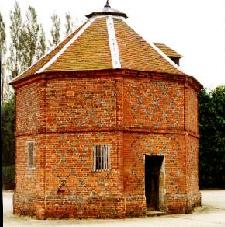 |
Stewkley possesses both a "Manor Farm" and "Dovecote Farm"; but it is at the former that we find a dovecote standing at a few yards' distance from the house. It is an interesting specimen of early eighteenth-century work; brick, and octagonal in form. The bricks are laid in what is known to builders as the "Flemish bond," the "headers" - those bricks, namely, which present their ends to view - being black and arranged to form a diamond pattern. The dormer window and the lantern in the roof are both modern. The string-course round the walls is made of moulded bricks, while pilasters adorn the angles. The doorway has a segmental head. Immediately above it, on a plaster panel framed in molded-brick, are the initials and date, H.G.A. 1704. | We were directed to the Manor Farm
dovecote at Stwekley by a friendly man working in his yard. It is behind
a gate on the grounds of a business. We took a picture or two through the
gate and then took some better ones from the back yard of a newly-constructed
and still vacant house next door. The brickwork on the dovecote is quite
pretty. In fact, the whole village is interesting and has very old houses.
The friendly man has an outbuilding in his yard that used to be a bakery,
and his own house was originally three connected cottages. October 4, 1998
We read in A Fancy for Pigeons
that the darker colored was made so by placing the brick onto burning gorse
bushes, a practice still used there today. Kligerman also notes that
there are still nearly a 1,000 nest holes. |
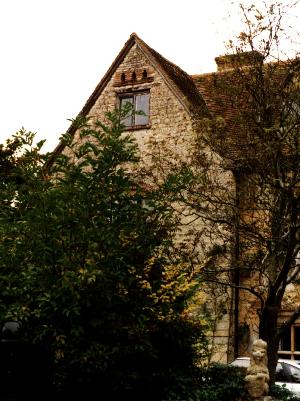 |
In Whitchurch, at a house in
a lane south of the church, we find a Buckinghamshire example of pigeons
being accommodated in a dwelling. In the north gable of this house are two
rows of entrance-holes. Again, at Cuddington, the village club has taken
possession of what was formerly Tyringham Hall, a house constructed in the
seventeenth century. In one of the attics may be seen some nest-holes built
of brick.
We found this very beautiful house called Tyringham
Hall, with the pigeon entrance holes still intact in the gable. You can see
the entrance holes just above the dormer window. It is now being used as
a single family residence, and the pigeon holes are just an architectural
feature of the exterior facade. October 4, 1998 . |
|
|
|
||
| At Burnham Abbey, a little south of the main buildings, is a good sixteenth-century dovecote; square, and built of two and a quarter inch bricks. The doorway is modern, but below the eaves on the east wall is a curious little window having a three-centered head. The roof is thatched, and hipped on all four sides. | ||
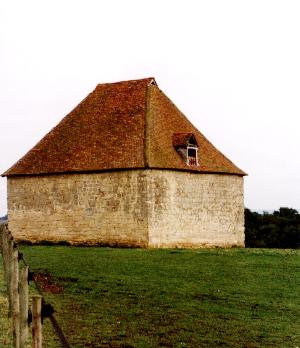 |
Finally, a dovecote with fittings of unusual style stands in the grounds of the thirteenth century Notley Abbey, at Long Crendon. It is a good-sized building of stone, square, with a tiled hipped roof, and is seemingly a survival from the Middle Ages. But its most striking feature will be found within. Projecting inwards from the walls are shorter walls, all fitted with nest-holes. This arrangement, obviously economical of space, permits of provision for between four and five thousand pairs of birds. One is inclined to wonder why this method of obtaining much additional accommodation was not oftener used. The only possible objection which occurs is that of overcrowding and diminution of air-space, a point on which the medieval builder was not over strict. What is clear is that the plan was seldom followed, this being the only instance so far brought to notice. | This dovecote was found by using
a nice brochure about parish walks, which we got at a pub in Long Crendon.
The easiest way to get to it is actually to walk from the village of Chearsley.
The path goes through fields, across train tracks, and through some pasture
land with sheep, to Notley Farm. Unfortunately, the place was crawling with
mean dogs, so we did not approach the dovecote. It is in good condition on
the outside, and we were disappointed to miss seeing the unusual interior.
October 4, 1998. We did learn from A Fancy for pigeons that the wall
are 18 feet high and 36 feet long on the long side. |
|
|
||
| The county of Huntingdon must be passed over
with the notice of a solitary but very fine example - that of the beautiful
dovecote standing in a small paddock at Grove House, Fenstanton, near St.
Ives. It is believed to have been built about a century ago, its form and
details being copied from one seen in Italy. It is remarkable for its height; the dome, supported on six slender pillars, being fifty-two feet from the ground; the weather-vane - a cock - adds four feet more. It is a brick building, circular, with a circumference of some sixty feet. There is a handsome string-course, with some ornamental work beneath the eaves. It has four stories, and provides accommodation for about one thousand pairs of birds: The present occupants are chiefly owls and daws, who, under the genial sway of a bird-loving owner, hold their lofty fortress in unchallenged peace. At this point, having now explored some parts of the Welsh Border and the Midlands, it may be not uninteresting to record some instances, scattered over various districts, in which pigeons were at one time suffered, even encouraged, to inhabit quarters wholly unconnected with them in the modern reader's mind. We have already seen them dwell securely in the tower of a church in Worcestershire; even more striking cases may be found elsewhere |
||
Dovecote: Table of Contents |
|
